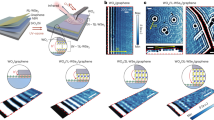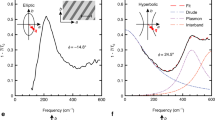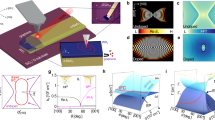Abstract
Photonic crystals and metamaterials have emerged as two classes of tailorable materials that enable the precise control of light. Plasmonic crystals, which can be thought of as photonic crystals fabricated from plasmonic materials, Bragg scatter incident electromagnetic waves from a repeated unit cell. However, plasmonic crystals, like metamaterials, are composed of subwavelength unit cells. Here, we study terahertz plasmonic crystals of several periods in a two-dimensional electron gas. This plasmonic medium is both extremely subwavelength (∼λ/100) and reconfigurable through the application of voltages to metal electrodes. Weakly localized crystal surface states known as Tamm states are observed. By introducing an independently controlled plasmonic defect that interacts with the Tamm states, we demonstrate a frequency-agile electromagnetically induced transparency phenomenon. The observed 50% in situ tuning of the plasmonic crystal band edges should be realizable in materials such as graphene to actively control plasmonic crystal dispersion in the infrared.
This is a preview of subscription content, access via your institution
Access options
Subscribe to this journal
Receive 12 print issues and online access
$209.00 per year
only $17.42 per issue
Buy this article
- Purchase on Springer Link
- Instant access to full article PDF
Prices may be subject to local taxes which are calculated during checkout




Similar content being viewed by others
References
Yablonovitch, E., Gmitter, T. J. & Leung, K. M. Photonic band structure: the face-centered-cubic case employing nonspherical atoms. Phys. Rev. Lett. 67, 2295–2298 (1991).
Yoshie, T. et al. Vacuum Rabi splitting with a single quantum dot in a photonic crystal nanocavity. Nature 432, 200–203 (2004).
Baba, T. Slow light in photonic crystals. Nature Photon. 2, 465–473 (2008).
Berrier, A. et al. Negative refraction at infrared wavelengths in a two-dimensional photonic crystal. Phys. Rev. Lett. 93, 073902 (2004).
Yablonovitch, E. Inhibited spontaneous emission in solid-state physics and electronics. Phys. Rev. Lett. 58, 2059–2062 (1987).
John, S. Strong localization of photons in certain disordered dielectric superlattices. Phys. Rev. Lett. 58, 2486–2489 (1987).
Allen, S. J., Tsui, D. C. & Logan, R. A. Observation of the two-dimensional plasmon in silicon inversion layers. Phys. Rev. Lett. 38, 980–983 (1977).
Dyakonov, M. I. & Shur, M. S. Detection, mixing, and frequency multiplication of terahertz radiation by two-dimensional electronic fluid. IEEE Trans. Electron Dev. 43, 380–387 (1996).
Ju, L. et al. Graphene plasmonics for tunable terahertz metamaterials. Nature Nanotech. 6, 630–634 (2011).
Yan, H. et al. Tunable infrared plasmonic devices using graphene/insulator stacks. Nature Nanotech. 7, 330–334 (2012).
Grigorenko, A. N., Polini, M. & Novoselov, K. S. Graphene plasmonics. Nature Photon. 6, 749–758 (2012).
Mackens, U., Heitmann, D., Prager, L., Kotthaus, J. P. & Beinvogl, W. Minigaps in the plasmon dispersion of a two-dimensional electron gas with spatially modulated charge density. Phys. Rev. Lett. 53, 1485–1488 (1984).
Muravev, V. M. et al. Tunable plasmonic crystals for edge magnetoplasmons of a two-dimensional electron system. Phys. Rev. Lett. 101, 216801 (2008).
Dyer, G. C. et al. Inducing an incipient terahertz finite plasmonic crystal in coupled two dimensional plasmonic cavities. Phys. Rev. Lett. 109, 126803 (2012).
Andress, W. F. et al. Ultra-subwavelength two-dimensional plasmonic circuits. Nano Lett. 12, 2272–2277 (2012).
Burke, P. J., Spielman, I. B., Eisenstein, J. P., Pfeiffer, L. N. & West, K. W. High frequency conductivity of the high-mobility two-dimensional electron gas. Appl. Phys. Lett. 76, 745–747 (2000).
Rana, F. Graphene terahertz plasmon oscillators. IEEE Trans. Nanotechnol. 7, 91–99 (2008).
Staffaroni, M., Conway, J., Vedantam, S., Tang, J. & Yablonovitch, E. Circuit analysis in metal-optics. Phot. Nano. Fund. Appl. 10, 166–176 (2012).
Aizin, G. R. & Dyer, G. C. Transmission line theory of collective plasma excitations in periodic two-dimensional electron systems: finite plasmonic crystals and Tamm states. Phys. Rev. B 86, 235316 (2012).
Shvets, G. & Urzhumov, Y. A. Engineering the electromagnetic properties of periodic nanostructures using electrostatic resonances. Phys. Rev. Lett. 93, 243902 (2004).
Lemoult, F., Lerosey, G., de Rosny, J. & Fink, M. Resonant metalenses for breaking the diffraction barrier. Phys. Rev. Lett. 104, 203901 (2010).
Lemoult, F., Fink, M. & Lerosey, G. Acoustic resonators for far-field control of sound on a subwavelength scale. Phys. Rev. Lett. 107, 064301 (2011).
Liu, Z. et al. Locally resonant sonic materials. Science 289, 1734–1736 (2000).
Davanco, M., Urzhumov, Y. & Shvets, G. The complex Bloch bands of a 2D plasmonic crystal displaying isotropic negative refraction. Opt. Express 15, 9681–9691 (2007).
Tamm, I. E. Uber eine mogliche Art der Elektronenbindung an Kristalloberflachen. Phys. Z. Sowjetunion 1, 733–736 (1932).
Shaner, E. A. et al. Far-infrared spectrum analysis using plasmon modes in a quantum-well transistor. IEEE Photon. Technol. Lett. 18, 1925–1927 (2006).
Davoyan, A. R., Popov, V. V. & Nikitov, S. A. Tailoring terahertz near-field enhancement via two-dimensional plasmons. Phys. Rev. Lett. 108, 127401 (2012).
Smith, D. R., Vier, D. C., Koschny, T. & Soukoulis, C. M. Electromagnetic parameter retrieval from inhomogeneous metamaterials. Phys. Rev. E 71, 036617 (2005).
Simovski, C. R. Bloch material parameters of magneto-dielectric metamaterials and the concept of Bloch lattices. Metamaterials 1, 62–80 (2007).
Yoon, H., Yeung, K. Y. M., Umansky, V. & Ham, D. A Newtonian approach to extraordinarily strong negative refraction. Nature 488, 65–69 (2012).
Ohno, H. et al. Observation of ‘Tamm states’ in superlattices. Phys. Rev. Lett. 64, 2555–2558 (1990).
Goto, T. et al. Optical Tamm states in one-dimensional magnetophotonic structures. Phys. Rev. Lett. 101, 113902 (2008).
Sasin, M. E. et al. Tamm plasmon polaritons: slow and spatially compact light. Appl. Phys. Lett. 92, 251112 (2008).
Muravev, V. M. & Kukushkin, I. V. Plasmonic detector/spectrometer of subterahertz radiation based on two-dimensional electron system with embedded defect. Appl. Phys. Lett. 100, 082102 (2012).
Zhang, S., Genov, D. A., Wang, Y., Liu, M. & Zhang, X. Plasmon-induced transparency in metamaterials. Phys. Rev. Lett. 101, 047401 (2008).
Liu, N. et al. Plasmonic analogue of electromagnetically induced transparency at the drude damping limit. Nature Mater. 8, 758–762 (2009).
Tassin, P., Zhang, L., Koschny, T., Economou, E. N. & Soukoulis, C. M. Low-loss metamaterials based on classical electromagnetically induced transparency. Phys. Rev. Lett. 102, 053901 (2009).
Luk'yanchuk, B. et al. The Fano resonance in plasmonic nanostructures and metamaterials. Nature Mater. 9, 707–715 (2010).
Fowler, R. H. Notes on some electronic properties of conductors and insulators. Proc. R. Soc. Lond. A 141, 56–71 (1933).
Shockley, W. On the surface states associated with a periodic potential. Phys. Rev. 56, 317–323 (1939).
Totsuka, K., Kobayashi, N. & Tomita, M. Slow light in coupled-resonator-induced transparency. Phys. Rev. Lett. 98, 213904 (2007).
Vakil, A. & Engheta, N. Transformation optics using graphene. Science 332, 1291–1294 (2011).
Muravjov, A. V. et al. Temperature dependence of plasmonic terahertz absorption in grating-gate gallium-nitride transistor structures. Appl. Phys. Lett. 96, 042105 (2010).
Chen, J. et al. Optical nano-imaging of gate-tunable graphene plasmons. Nature 487, 77–81 (2012).
Fei, Z. et al. Gate-tuning of graphene plasmons revealed by infrared nano-imaging. Nature 487, 82–85 (2012).
Sydoruk, O., Syms, R. R. A. & Solymar, L. Distributed gain in plasmonic reflectors and its use for terahertz generation. Opt. Express 20, 19618–19627 (2012).
Dyer, G. C. et al. Enhanced performance of resonant sub-terahertz detection in a plasmonic cavity. Appl. Phys. Lett. 100, 083506 (2012).
Lisauskas, A. et al. Rational design of high-responsivity detectors of terahertz radiation based on distributed self-mixing in silicon field-effect transistors. J. Appl. Phys. 105, 114511 (2009).
Preu, S. et al. Terahertz detection by a homodyne field effect transistor multiplicative mixer. IEEE Trans. THz Sci. Technol. 2, 278–283 (2012).
Klimenko, O. A. et al. Temperature enhancement of terahertz responsivity of plasma field effect transistors. J. Appl. Phys. 112, 014506 (2012).
Acknowledgements
The work at Sandia National Laboratories was supported by the Department of Energy Office of Basic Energy Sciences. This work was performed, in part, at the Center for Integrated Nanotechnologies, a US Department of Energy, Office of Basic Energy Sciences user facility. Sandia National Laboratories is a multi-program laboratory managed and operated by Sandia Corporation, a wholly owned subsidiary of Lockheed Martin Corporation, for the US Department of Energy's National Nuclear Security Administration (contract DE-AC04-94AL85000).
Author information
Authors and Affiliations
Contributions
G.C.D., S.J.A. and E.A.S. conceived and designed the devices. J.L.R. grew the 2DEG material. E.A.S. and D.B. fabricated and imaged the devices. A.D.G. and G.C.D. assembled the experiment. G.C.D. measured and analysed the data. G.R.A. and G.C.D. developed the theory and performed the model computations. G.C.D. wrote the manuscript with editorial input from G.R.A. and E.A.S. All authors discussed the results and commented on the paper.
Corresponding authors
Ethics declarations
Competing interests
The authors declare no competing financial interests.
Supplementary information
Supplementary information
Supplementary information (PDF 1241 kb)
Rights and permissions
About this article
Cite this article
Dyer, G., Aizin, G., Allen, S. et al. Induced transparency by coupling of Tamm and defect states in tunable terahertz plasmonic crystals. Nature Photon 7, 925–930 (2013). https://doi.org/10.1038/nphoton.2013.252
Received:
Accepted:
Published:
Issue Date:
DOI: https://doi.org/10.1038/nphoton.2013.252
This article is cited by
-
Electromagnetically induced transparency at a chiral exceptional point
Nature Physics (2020)
-
Graphene-plasmon polaritons: From fundamental properties to potential applications
Frontiers of Physics (2016)
-
Excitation, detection and electrostatic manipulation of terahertz-frequency range plasmons in a two-dimensional electron system
Scientific Reports (2015)



